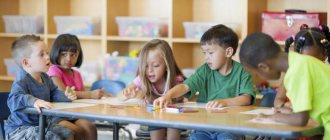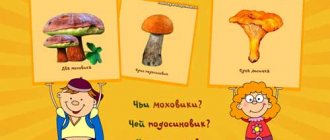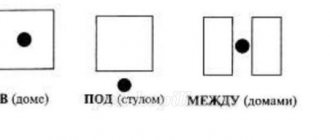Article “Organization of speech development classes in a nursery group”
Organization of speech development classes
with children from the nursery group of the kindergarten.
F. M. Mugotleva, teacher
MBDOU "Kindergarten No. 23" Berezka ", Maykop
Activities with children in the nursery group are playful in nature. However, they have certain goals, objectives, and means for their implementation and thus differ from games. From the very beginning of classes, the teacher sets a goal - to instill in children certain rules of behavior: not to disturb others, maintain the correct posture, listen carefully and perceive what is being shown. Children's observance of rules of behavior soon becomes a habit, and the result of an action, movement, or word performed serves as a source of joy.
The education of young children is unique. Firstly, they not only have no motives for learning activities, but also lack conscious, voluntary actions necessary for learning, and the acquisition of first knowledge and skills occurs on the basis of involuntary memorization. Secondly, in spite of everything, young children have a high level of learning ability, that is, the learning process begins long before this type of activity becomes the main one in the child’s mental development.
Speech classes are the most difficult for children, require tension and therefore should be short. When fatigue appears, children are either involved in the activity or finished early. It is important that the kids get complete satisfaction from the lesson.
In order for children to be less distracted during the lesson and it to be more effective, it is advisable to organize it in a different room, not where those who are not engaged are playing. This could be a reception room, a well-lit bedroom.
It is important to provide the most comfortable position for the child during classes, which will help him maintain attention for a long time. Children often play while sitting on the floor, so they do not develop differentiation well, so that during classes they need to behave differently than during play. They jump up, crawl around, grab toys, get distracted. Sitting on the carpet with your legs outstretched is not a comfortable position; children get tired quickly. They are trying to change it. And at this moment he interferes with another child.
If children at the beginning of the 2nd year are seated during class on semicircular chairs at some distance from the teacher, they jump out of their seats and run to her as soon as she starts showing a picture or toy. The posture of a child of this age, without support on the table, is often incorrect. It is best to conduct classes at shifted tables, thereby unobtrusively and from the very beginning limiting the child’s desire to get up and grab the toy being shown.
The duration of classes in the 2nd year of life varies from several to 10 minutes, and an indicator that the classes need to be completed is a decrease in activity and distractibility of children. At this age, along with easy fatigue and distractibility, children experience insufficient mobility of nervous processes. It is expressed in long latent periods of speech responses, frequent after-effect responses, and a gradual increase in the child’s activity during the lesson.
The number of children in a lesson depends on their age and the material they will be working on. Uniting children in small groups in a lesson is only possible if each child is ready to learn and knows how to watch, listen, and act as instructed by an adult). The number of children participating in a lesson depends on the age of the children and on the type of lesson, on the degree of mastery of the skill (the less developed a particular skill is, the fewer children participate in the lesson).
The requirements for children must be feasible and not burdensome. Along with new material, it is advisable to use what is already familiar to children.
During the classes, the knowledge that is mastered during actions with objects, games, observations while walking, etc. is consolidated. The more meaningful a child’s daily life is, the greater the cognitive opportunities available for activities.
If an adult wants a child to repeat a word after him, his tone should be affectionate, but calm, businesslike, and not overly emotionally upbeat. Only by persistently repeating the instructions can you get the child to focus on the adult’s face, listen and respond. But it goes without saying that there should be no rough training or coercion here under any circumstances.
You should cultivate in children the need to speak, constantly create situations in which the child is forced to utter words and phrases: you need to ask an adult for something, convey his instructions in words.
The child’s ability to imitate must be developed so much that he can easily repeat a new word after an adult and, as they say, “on the fly” add this word to his active vocabulary.
During classes on familiarization with the environment and development of speech for children of the third year of life, cognitive activity develops. The content of classes is determined by the program material, which includes knowledge that the child cannot master on his own. Classes should be predominantly problem-based in nature, which:
- ensures their developmental character;
-has not only a teaching, but also an educational effect;
-creates a special interest in acquiring knowledge.
As a result, in the third year of life the semantic side of speech, the functions of comparison and generalization, grammatical structure and articulation intensively develop.
In conclusion, it should be noted that we constantly work with children of primary preschool age and at the end of the school year we present our results to the teachers of the older groups to whom our pupils move.
Summary of a lesson on the speech development of children in the nursery group. Pets
Summary of a lesson on speech development of children in the nursery group “House for Bobik the Puppy”
Goal: to create conditions for the development of speech activity in children. Objectives: 1. Continue to introduce pets: puppy, cat, horse 2. Develop attention, memory, observation, thinking, and the ability to perform various game tasks. 3. Develop the ability to conduct a dialogue with the teacher. 4. Cultivate kindness and responsiveness, an emotionally positive attitude, and a desire to help. Didactic material: toy puppy, cat, horse, basket with gifts, magnetic board, basket with treats.
Decoration of a forest clearing. Progress of the lesson
Organizational moment Educator: Hello, guys!!! How beautiful, sweet and good you are today!!! Do you like to play? Of course you love it!!! Children: yes!!! Educator: Then let's start!!! Repeat after me bolder and more fun!!! Game “If life is fun, do this” If life is fun, do this (clap) If life is fun, do this (clap) If life is fun, we will smile at each other If life is fun, do this (clap) If life is fun, do this (stomp) If life is fun, do this (stomp) If life is fun, we will smile at each other If life is fun, do this (stomp) If life is fun, do this (jump) If life is fun, do this (jump) If life is fun, do this (jump) If life is fun, do this (jump) , we will smile at each other. If life is fun, do this (jump) (Children perform all the actions for the teacher)
The main part of the lesson
Teacher: Oh, do you hear, guys, someone is crying? ... (the teacher listens, then goes to cry) look, right here... Who is this? (takes the children and shows them under a bush. Under the bush is a puppy. The teacher asks the children questions about the animal: what is it like?) What happened to you, my friend? (the teacher takes out and picks up a toy - a puppy, hugs and feels sorry for him). Don't cry, our good, cute little dog!!! (Listens to him, and tells the children, from the words of the puppy) The puppy told me that his name is Bobik. And he cries because the bear has broken his house and now he has no place to live. How can we help Bobik? How can we please him? Children: The puppy needs to build a house! Educator: Absolutely right! You guys are so good!!! We will help you, Bobik, make a new home, it will be much better than the previous one (addresses the puppy). And our friends and assistants will help us with this. Shall we go visit them? Children: yes Teacher: Let's go to them by car. How does the car sound? Children : bib-bib (The teacher plays the game together with the children) Game “I’ll start my car” I’ll start my car. Beep, beep, I'll pour some gasoline. I'll take the steering wheel firmly and firmly. I'll press the pedal with my foot! (The teacher and the children go to visit for help. The song “I’m driving, driving, driving. I’m turning the steering wheel, turning it” sounds. Teacher: And here is our first assistant. (The teacher points to the horse) Who is this? Guys, did you find out? Children: Horse! Educator: That's right! It's a horse! Hello, horse! We really need your help! Bear broke puppy Bobik’s house, now he has nowhere to live, please help the guys and I build a new house! (The teacher addresses the horse) Children, let's ask for a horse together! Children: Horse! Please help us build a house! Educator : You know, the horse loves it when people tell rhymes about it, let’s please the horse and tell a rhyme? (The teacher invites the children to recite the poem). Poem by Agnia Barto “Horse” I love my horse, I will comb its fur smoothly, I will smooth its tail with a comb, and I will go on horseback to visit. Educator : The horse says thank you very much to us and gives us a gift, this gift is not an easy one. He will help us make the puppy happy. (The teacher thanks the horse together with the children) (The teacher and the children continue their journey. The song “I’m going, I’m going, I’m going. I’m turning the steering wheel, I’m turning)” Educator : And here’s another assistant. (The teacher points to the cat) Who is this? Guys, did you find out? Children: Kitty! Educator: Which one, cat? What does he like to eat? What does the cat say? Children : Cat, cute, fluffy, gray. He loves to drink milk. Purrrrrrr... Educator : That's right! This is a cat - a gray belly! Hello, cat! We really need your help! Bear broke puppy Bobik’s house, now he has nowhere to live, please help the guys and I build a new house! (The teacher addresses the cat) Children, let's ask together! Children : Cat! Please help us build a house! Educator: You know, the cat really loves rhymes, nursery rhymes, songs, let’s please our friend and tell him a rhyme? (The teacher invites the children to tell the children the nursery rhyme “Like our cat’s”) Like our cat’s fur coat is very good. Like a cat's mustache of amazing beauty. Bold eyes, white teeth. Educator: The cat says thank you very much and gives us a gift. This gift is not simple. He will help us make the puppy happy. (The teacher thanks the cat together with the children) (The teacher addresses the children) Now it’s time for us to go to the puppy to help build a house. (The teacher and the children return back in the car. The song “I’m driving, driving, driving. I’m turning the steering wheel, turning it” plays. Educator: So we’re back, it’s time to get down to business! Finger gymnastics “Building a house” Knock, knock, knock, knock (We tap the fist of our right hand on the outstretched palm of our left hand.) A loud sound is heard. (The same movement, but we change hands.) We build Bobik a house, (We place fist on fist one by one .) He will live in it, in it. This is the roof, the bright window (We raise our palms, join our fingers, depicting the roof of the house, then the window) It will be cozy and warm here. (Children perform all actions after the teacher.) Final part of the lesson The teacher connects the two parts of the house on a magnetic board. Shows the children what they did. He says that the puppy is very happy and thanks everyone who helped him for the help. He gives the kids candy and says goodbye to them.
We recommend watching:
Summary of educational activities for sensory education with children of the first junior group Developmental activities with young children 2-3 years old Summary of a lesson on speech development in a nursery group. Visiting Belochka Abstract of the OOD on cognitive development (FCDM) “Dandelion” for children of the early age group (2-3 years old)
Similar articles:
Lesson summary for the first early age group on the topic: Toys
Summary of a lesson on social development in an early age group
Summary of a lesson on familiarization with the natural world in the first junior group




